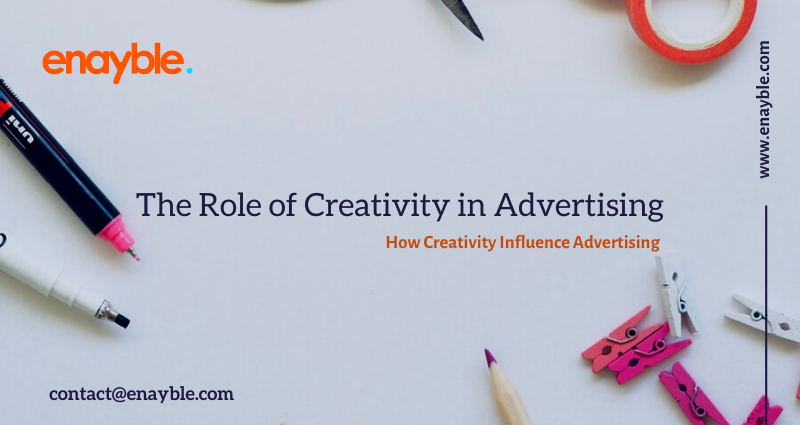How Creativity Influence Advertising

Advertising leverages ideas that highlight some critical features of the creative process. When it comes to creativity, it is fairly hard to define how it works. Creativity is a reflection of thoughts, an art that is not subjected to specific rules. Creativity cannot be simply called into existence; it requires a free, unrestricted flow of ideas to bring a concrete one into existence. Creativity often means proposing elegantly simple expressions for complex issues to bring out a substantial solution. Truly creative individuals express their ideas that are a mix of personal opinions and interpretations of essential truth.
Creativity is all about coming up with clear solutions, doing things a little differently, and finding unique ways to solve a problem. This is especially applied to the advertising industry, where truly original ideas are required to spread the message.
Advertising in marketing creates a sense of urgency for the customer. It is a medium to develop honest awareness amongst the customers about products, services, places, styles, or sensibilities that demand attention, action and reaction. Today, there are various styles of advertising depending on the nature of the product or the brand, a soft sell or a hard sell, s subtle approach or a blatant one, an informative style, humorous or an edgy one. Style is dynamic in nature; it will always change with regards to the product being sold, with the type of the message and with the medium of advertising being used at the moment. The most crucial aspect is engaging with the customers to find out whether the blend of ideas is serving its purpose or not.
Creativity in Advertising: a brief history
The idea of creativity in advertising was not much discussed much until the 1960s, after which a wave of change in the way of producing advertising transformed the field for generations to come. The fundamental feature if this Creative Revolution was that creativity came to be valued over the formulas and ideas that previously drove the production of ads and commercials.
A creative team, which is a mainstay of nearly all agencies since the 1960s, did not exist prior to that time. Reason-why advertising that spoke to the customers in terms of unique selling propositions of the product was the reigning paradigm at that time. Most companies were producing hard-hitting advertising; the approach worked by hammering messages into the customers’ minds, sometimes rather literally. Customers did not enjoy these advertisements, even if they understood the message. Critics within the advertising field felt the ads lacked finesse, subtlety, or creativity. The new wave in the advertising style in the 1960s would produce ads that were both highly communicative in nature and were liked by customers.
The genius in the advertising process lay in placing creativity before research. The creative teams started ditching programmatic approaches to advertising. Advertising needed to respect the consumers’ intelligence and communicate through simple, clear, and precise images and words. The work was aimed to look more witty and sophisticated.
As the relationship between the client company and the agency matures, the advertising strategy became more sharply defined. The definitional process of incorporating creativity in advertising was helped by insights from focus groups and other forms of consumer research. The research helped identify various barriers that influenced the decision-making process of consumers and the factors that drove the shift from one brand to another. Using this information, the agency and the client worked together to develop a specific strategy, to break down the barriers responsible for making the customers switch through brands.
Advertising Today:
The continuous evolution of the Internet has allowed for more and more internet-based advertising formats to be offered in the market. In fact, today, online advertising has become a field of its own. Online advertising has served as a great medium to increase brand awareness and improved sales. The fact that this is a virtual world crammed with super-companies and big brands, alongside adverts of smaller brands and medium scale brands. This creates a sense of equality in the exposure of the brand and that has nothing to do with the size of the brand.
Companies are using various methods of online advertising, incorporating creativity and fresh ideas to bring about a precise and memorable ad campaign. As online advertising picked up the pace, native advertising emerged as a more unconventional way of online advertising. In other words, the strategy involves trying to win a user’s trust by offering the solution to their problems. Blogging done for native advertising provides brilliant results. Including something useful and interesting for the users, talking about something related to the sector, and not making it entirely about advertising promotes customer engaged and builds trust around the skillset of the company.
Search Engine Marketing is another widely used form of online advertising. The goal here is to achieve increased brand awareness in a relatively shorter period of time. The process is relatively simple, it requires an ad with a title, a description and a call to action, with just the right amount of keywords. Depending on the website and the product/service being offered, the ad will be displayed when the users type in the preselected keywords in the search engine.
Visuals play a significant role in all forms of advertising. Among the more ‘visual’ set of online advertising, formats are display ads. They generally contain images or videos and are published in designated places within any given website. Display ads include blogs, journals or a site aimed at a specific group. Mobile advertising is also a vital feat to achieve these days as most users are on their smartphones or tablets and are constantly on the move. Moreover, they use these devices to access the internet. As of 2016, Google said more traffic has now surpassed that of desktop computers. Hence, mobile advertising took off, providing a better reach, and improved user interaction.
Social media is also an incredibly useful platform for advertising. It is made up of channels through which people connect multiple times a day and where they frequently communicate, share, and express their opinions. Creating ad campaigns for these platforms is necessary for generating brand awareness and for acquiring potential new clients. Also, thanks to the vast segmented possibilities social networks offer, they can be the perfect places to launch new products/services geared towards specific audiences. If the goal is to make conversions or to implement a branding strategy, social media is a great option.
Video content is also an incredibly entertaining resource for users. Several companies are using creative and informative videos in their advertising strategy. Influencers on social media and Google’s video platform YouTube who feature and discuss the product and service, similar to native advertising. By sharing videos and keeping creativity on the forefront, websites receive direct traffic, attracting more and more customers.
Bottom Line:
The importance of creativity factor in advertising has got wide recognition by many marketers and practitioners, and systematic research justifies the use of creativity and its effectiveness in advertising. The key is to find the right balance between defining a good creative message and execution. The real craft in identifying ways to interest consumers in what is being offered. An innovative strategy helps put a brand on the right course, but in a world full of distraction and clutter, it is crucial to develop communication strategies that capture consumer attention and interest, delivering the selling point in an interesting, single-minded and non-contrived manner. Some advertising sells brands, but great advertising builds them.
